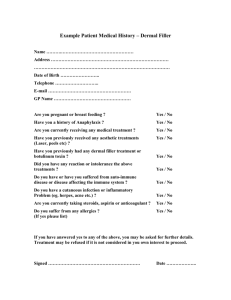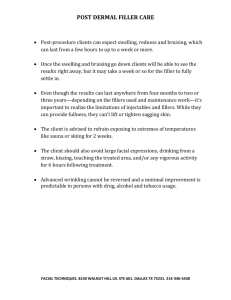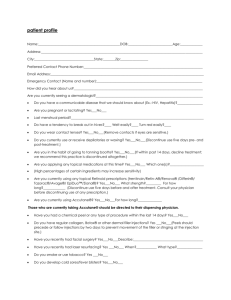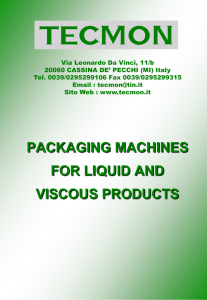esl filling & capping overview
advertisement
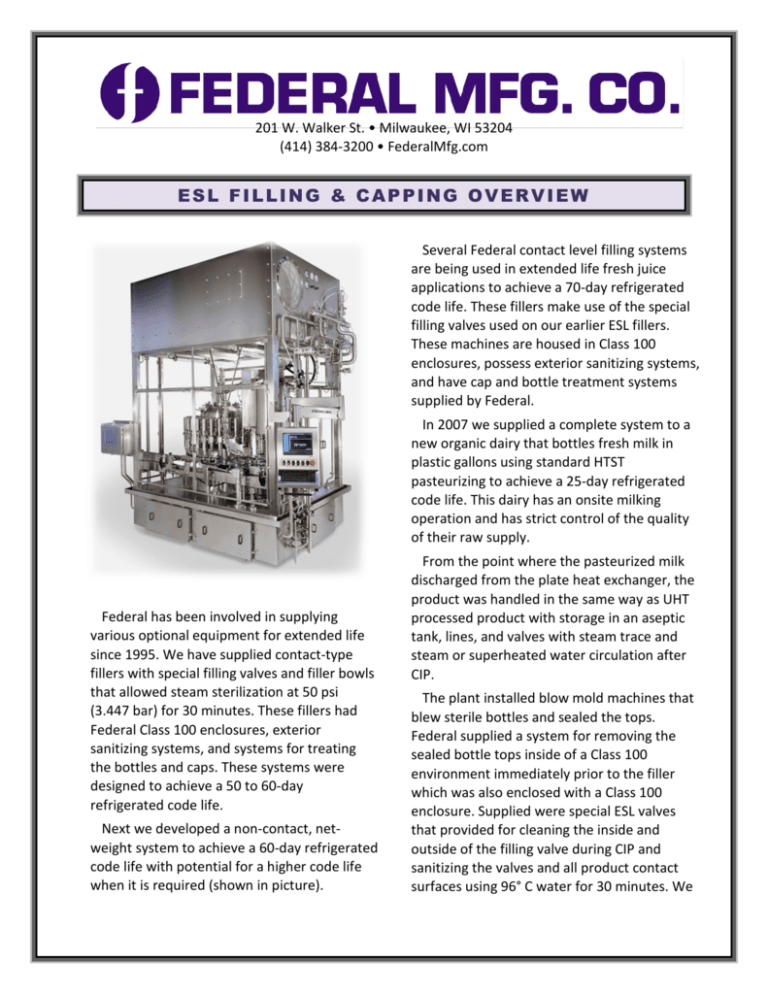
201 W. Walker St. • Milwaukee, WI 53204 (414) 384-3200 • FederalMfg.com ESL FILLING & CAPPING OVERVIEW Several Federal contact level filling systems are being used in extended life fresh juice applications to achieve a 70-day refrigerated code life. These fillers make use of the special filling valves used on our earlier ESL fillers. These machines are housed in Class 100 enclosures, possess exterior sanitizing systems, and have cap and bottle treatment systems supplied by Federal. In 2007 we supplied a complete system to a new organic dairy that bottles fresh milk in plastic gallons using standard HTST pasteurizing to achieve a 25-day refrigerated code life. This dairy has an onsite milking operation and has strict control of the quality of their raw supply. Federal has been involved in supplying various optional equipment for extended life since 1995. We have supplied contact-type fillers with special filling valves and filler bowls that allowed steam sterilization at 50 psi (3.447 bar) for 30 minutes. These fillers had Federal Class 100 enclosures, exterior sanitizing systems, and systems for treating the bottles and caps. These systems were designed to achieve a 50 to 60-day refrigerated code life. Next we developed a non-contact, netweight system to achieve a 60-day refrigerated code life with potential for a higher code life when it is required (shown in picture). From the point where the pasteurized milk discharged from the plate heat exchanger, the product was handled in the same way as UHT processed product with storage in an aseptic tank, lines, and valves with steam trace and steam or superheated water circulation after CIP. The plant installed blow mold machines that blew sterile bottles and sealed the tops. Federal supplied a system for removing the sealed bottle tops inside of a Class 100 environment immediately prior to the filler which was also enclosed with a Class 100 enclosure. Supplied were special ESL valves that provided for cleaning the inside and outside of the filling valve during CIP and sanitizing the valves and all product contact surfaces using 96° C water for 30 minutes. We 201 W. Walker St. • Milwaukee, WI 53204 (414) 384-3200 • FederalMfg.com treated the screw caps with a 1% peroxide spray followed with a UV light. Screw caps had a soft compression liner to achieve a secure seal. Following are some choices to make in treatment of product, containers, closures, and filling environment. The filler bowl was a sealed vessel with a slight pressure of sterile air to blanket the headspace above the product. We supplied the sterile air and the provisions to steam sterilize the system after each production run. We supplied the same type of CIP/SIP system that we have supplied for your plant except for some additional controls. PRODUCT The goal in this operation was to receive the milk from processing, fill and cap the bottle, and not add to the bacteria count of the product from what it was when it left the plate heat exchanger. We were able to achieve this consistently. CONTAINER ESL OVERVIEW ESL can be defined as an operation where a juice product or food product is expected to carry a refrigerated expiration code date of 30 to 90 days. This period of time is controlled by the treatment of the product, containers, closures and the filling and capping environment. The type of package used is an important factor. Although the treatment during the filling and capping operation may produce an extended code life, the materials in the package may not protect the flavor of the product or maintain the nutrient value of the product. A balance between packaging cost and a practical code life must be considered in determining the code life goal. The normal choices of packaging materials for ESL are HDPE or PET. It is important to start with a raw product that is being produced under strict sanitary conditions and maintained under good refrigerated conditions to avoid unnecessary contamination and to keep contamination growth to a minimum. Plastic and PET bottles should be produced in a clean and sanitary environment and packaged in sealed plastic single-use bags. They should not be opened until they are in a sanitary environment. This environment should be one in which the air in the room is being filtered and a positive pressure maintained. The minimum treatment of the container is an air cleaning process. This treatment consists of a filtered air burst and a vacuum to extract dust or particles. This process can be expected to add two (2) days to the code life. The treatment required for ESL is with H202 (paracetic acid) solution. Bottles should be flushed or filled with a 60° Celsius H202 solution for 7.0-second exposure time. This is followed with a sterile water rinse and a sterile air burst to remove as much residual water as possible. When sterilized bottles discharge to the filler, they must be in a covered conveyor pressurized with HEPA filtered air. Federal can supply rotary-type rinsers or gripper-type rinsers with flood-fill systems. 201 W. Walker St. • Milwaukee, WI 53204 (414) 384-3200 • FederalMfg.com Federal also supplies package systems to produce sterile water, sterile air, sanitizer blending and circulating systems to supply the rinsers. The above process will provide a Log 35 reduction which is sufficient for a 70-day code life. Federal also has available a bottle sterilizing system using electron beams to produce kill rates to Log 6 or higher reduction for aseptic applications. In preparing the filler for filling product, the filler should be cleaned with a chlorinated detergent using an automated circulating system. Federal can supply a complete system including solution tanks or can supply a system where rinse and cleaning solutions are supplied from an existing central system. If juice products with pulp or particulates are being filled, some disassembly of the filling valve is required. CLOSURE AND CLOSURE TREATMENT After the cleaning process is completed, the automated circulating system is used for sterilization of all product contact surfaces. For ESL food product filling, Federal supplies the filler with an ASME coded filler bowl that can be pressurized with (50 psi) 3.5 bar of culinary steam. The normal treatment is (30 psi) 2.1 bar for 30 minutes. A cool-down of the filler bowl is required using refrigerated sterile air and sterile water from the process system. Federal can supply a package system to produce culinary steam. The sterile air system used to provide sterile air for bottle flushing can be built to include an air chiller to produce refrigerated sterile air. For ESL, a closure should be used that will assure that there will be no air leakage into the container. For a PET bottle, a good quality plug seal-type closure may be sufficient. For an HDPE container, a heat seal foil-lined closure with a back-up liner is recommended. The liner should be a non-absorbent synthetic material. Sealing should be with an induction closure sealer. If lined closures are used, the closures should be irradiated and maintained in sealed plastic bags until they are fed into the dispensing equipment. This treatment is not necessary for plug-style closures. Closure dispensing equipment should be located outside of the enclosed filling chamber. As the closure is sorted and dispensed, they are sprayed with a heated H202 solution of 30% and then passed through a UV light source to activate the sterilant and dry the closure. The sterilizing process should occur within the filler enclosure. FILLING AND CAPPING ENVIRONMENT Product Contact Surfaces: For juice filling applications, sterilization of product contact surfaces is with hot water at 96° C for 30 minutes. With hot water sterilization, a standard atmospheric filler bowl is supplied. The Federal ESL fillers are supplied with the Federal E-Series filling valve assembly t designed so that all seals are able to be cleaned and sanitized in place without disassembly, except in cases when there are particulates in the system. During the cleaning and sanitizing procedure, the filling valve is fully encapsulated to treat 201 W. Walker St. • Milwaukee, WI 53204 (414) 384-3200 • FederalMfg.com both the exterior and interior surfaces of the filling valve. Filler Enclosure: To provide a sterile environment for filling and capping, the monobloc filler/capper is enclosed with a stainless steel and polycarbonate enclosure with safety switches on all door openings. The filler cannot be operated with open doors. A remote HEPA filtered air supply system (High Efficiency Particulate Air Filter) is used to supply air via duct to the filler enclosure. The air in the filling room should be filtered to a 99.97% efficiency. The remote HEPA air supply system intake will draw air from the filling room to filter out 99.97% of particles that are 0.30 microns in size or larger and discharge the air into the filler enclosure and provide a laminar flow. The system is designed to meet or exceed Federal Class 100 specifications. Enclosures and air filter systems are available to filter out yeast and mold organisms. These systems provide for improved and consistent quality especially in juice filling operations. Maintaining a Clean and Sterile Environment: Once a sterile environment is achieved, it is imperative that provisions be made to maintain these conditions. As a component of the ESL system, an exterior sanitizing system is supplied. Spray devices supply sanitizer solution to all parts of the filler carousel, filler bowl, filling valves, capper table and capper turret. Once per hour or as necessary, a bottle brake is energized to stop the flow of bottles through the filler. After all bottles discharge from the filler, sanitizer is discharged through the spray devices for 15 seconds. Whenever it is necessary for the operator to go inside the enclosure, the flow of bottles is stopped and the sanitizer system is activated before the flow of bottles is allowed to resume. Isolated Filler Conveyor: The conveyor used to transport bottles into and out of the filler can be a source of contamination. To remedy this potential, an isolated conveyor infeed and drive is supplied and the conveyor chain is being sprayed with sanitizer anytime the conveyor is running. The drive is variable speed to match the speed of the filler. CONCLUSION: One key element of any ESL operation is the operating personnel. This is true regardless of the type of equipment or the amount of investment in the systems. Having operating personnel with the proper training and attitude is an absolute must. Federal states that the ESL system it provides still maintains the simplicity of the gravity filling system. The systems and the controls insure a sterile filling and capping environment with adequate provisions to maintain the sterility during long hours of operation. Some existing filling and capping systems may be upgraded to provide an ESL filling and capping system. From the very first ESL installation in 1995, Federal has proven that this simple system will provide consistent extended code life in the range of 45-70 days or longer.
